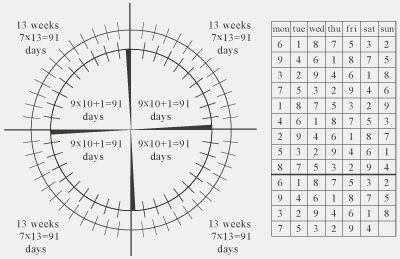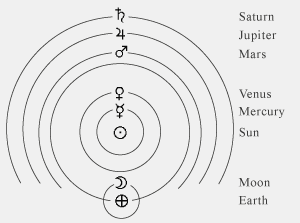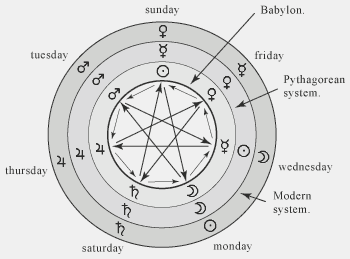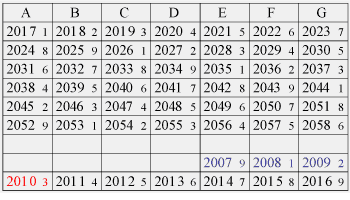 |
The pyramid Kukulkan at Chichen Itza has four sides and each side has nine terraces that is equal to number of ancient Egyptian Decans 4x9=36, and also sides of the pyramid Kukulkan have four staircases which conduct to the top platform. The number of steps on each staircase is 91 that is equal to quantity of days in four seasons of one year 91x4=364 provided that one day of real astronomical year is not taken into account. |
It is possible to assume that the architecture of pyramid Kukulkan has
ciphered numbers which form symbolical calendar system and form a cyclic
calendar in which year consists of 364 days and has the periodic beginning in
comparison with real astronomical year. Namely during one astronomical year the
beginning of symbolical year is shifted for 1 day and as a result in each 365
years the beginning of symbolical year periodically repeats, and displaced
concerning seasonal changes of a nature.
The similar calendar was known in Palestine and was applied in the Qumran
religious community, that we know from "manuscripts of the Dead sea". Namely in
the Qumran calendar year had 364 days and was divided into 4 seasons by duration
of 90 days plus 1 day at the end of each season that is shown on the chart:
 |
The calendar shown on the chart consists of 40 nine-day
periods which are designated on the internal circle, and also consists
of 52 seven-day periods (weeks) which are designated on the external
circle, i.e. each sector of the internal circle includes 9 days and each
sector of the external circle includes 7 days. Year is divided into 4 seasons, in each of which 90 days (9x10=90) correspond with numerological numbers and one day is "empty" and does not correspond with numbers (empty days are designated by dark sectors of the calendar circle). Days of week too correspond with numerological numbers, and each season within one year include the whole quantity of weeks (13x7=91x4=364 or 52x7=364) and consequently Sunday of last week in each season has no appropriate numerological number. |
On the right the chart shows the numerological table for one season in the
shown calendar where the concrete ratio of 13 weeks with numerological numbers
is specified, and other seasons are similar.
About synchronization of the Qumran calendar with real astronomical (Julian or
Gregorian) calendar I can not tell anything certain and consequently for use of
the shown calendar it is necessary to find any week and to compare Sunday of
this week to any dark sector provided that the choice of week depends on the
purposes which are caused by application of the Qumran calendar.
About existing connection of the Qumran calendar with numbers in numerology too
is not present authentic data, but nevertheless the shown calendar allows to
correlate the seven-day periods to nine numerological numbers that form the
unique computing system which differs from others used in numerology calendars.
As the seven-day periods (days of week) and numerological numbers are different
systems which describe the world by means of different character sets, but
mathematical system of the Qumran calendar allows to correlate diverse symbols.
Otherwise it is possible to tell that the Qumran calendar allows to correlate
numbers of septenary system of calculations to nine numbers of numerology.
Essence in that nine numbers in numerology symbolize nine phenomena of the
world, but the seven-day periods symbolize not phenomena of the world and seven
levels of display of phenomena in the world. Therefore directly it is impossible
to correlate numerological numbers to serial numbers of levels of the world, but
it is necessary to realize displays of numbers at different levels.
Traditionally seven-day periods correlate to seven seen astrological planets and
seven days of week and accordingly correlate to mythological gods who are
accepted for identifying with planets, but such ratio is not true though is
partly correct. As levels of the world have properties independent of gods, and
gods and planets are shown at seven levels with various degrees of concurrences
of own properties with properties of levels. Namely gods and planets are shown
at seven levels depending on own perception of those or other levels, and
associate with opportunities and properties which are shown at various levels.
For example, the planet Jupiter compare to the Roman god Jupiter or Greek Zeus
but it is not correct though the planet Jupiter conditionally is at a level of
the world where Jupiter or Zeus are most adequate and consequently in
consciousness of people the planet and the appropriate level of the world
associate with the Jupiter. It is possible to speak that seven heavens form
levels of the world and associate with gods, and gods form nine phenomena which
are shown in the world.
If to compare levels of the world to seven days of creation then in the first
day the world has found the first degree of display and has carried out
opportunities which are peculiar to the first level of a universe. In the second
day of creation the second degree of display of the world was carried out, and
so on during seven days levels of a universe were created. But it does not mean
that during seven days seven planets of solar system were created, though
planets associate with levels of the world and with days of week.
In ancient sources of the information various ratio of planets with days of week
are known. According to the Pythagorean sight on the world the sequence of
planets depends on seen (visual) sizes: Moon - Sun - Venus - Mercury - Mars -
Jupiter - Saturn, and according to the Babylon representation about a universe
the sequence of planets other and depends on speed of movements: Moon - Mercury
- Venus - Sun - Mars - Jupiter - Saturn. Accordingly ratio of levels of the
world with a sequence of planets can be different from the point of view of
different sources of the information.
The modern astrology accepts the traditional Babylon sequence of planets which
also was accepted in ancient Egypt and was known in philosophical concepts of
Aristotle in ancient Greece, and accordingly days of week correspond with
planets according to the Babylon tradition in the modern astrology.
It is necessary to tell that sequence of Plato was known in ancient Greece
except for sequence of Aristotle. This sequence differed other arrangement of
planets and corresponded to the valid astronomical orbits of planets that is
shown on the chart:
 |
As it is possible to see, the order of
the valid astronomical orbits corresponds to model of solar system and
corresponds to a sequence of planets in philosophical concepts of Plato,
namely: Moon - Sun - Mercury - Venus - Mars - Jupiter - Saturn. But also there can be a sequence: Moon - Venus - Mercury - Sun - Mars - Jupiter - Saturn. In the event that planets Venus and Mercury are located between the Earth and the Sun as a result of movement on orbits. |
Besides in the modern astrology there is a representation that planets have a sequence: Sun - Moon - Mercury - Venus - Mars - Jupiter - Saturn, that allows to correlate days of week and levels of the world to various sequences that is shown as the chart:
 |
In the centre of the chart there is a heptagonal star (the star of magians) with which radials seven planets correspond provided that planets are shown in three circles. The internal circle specifies a sequence of planets according to the Babylon system, the average circle specifies a sequence of planets according to Pythagorean system and the external circle specifies a sequence of planets according to modern astrological system. And also the chart shows ratio of planets with days of week provided that ratio of days with a sequence of planets in the Babylon system is traditional, and ratio of days with sequences of planets in Pythagorean and modern astrological systems is established by analogy to the Babylon system. The order of days is read according to radials in the star of magians, and sequences of planets are read on circles counter-clockwise, that is shown on the chart by arrows and corresponds to rules of the heptagonal star of magians which is known in the astrology. |
Pay attention that traditionally agrees to the Babylon system the first day
of week is a Sunday, but according to modern system the first day of week is a
Monday with which the Sun corresponds. In Pythagorean system the Sun corresponds
with Wednesday and consequently Wednesday should be the first day of week that
will be coordinated to calendar of the Qumran religious community in which too
the first day of week is a Wednesday. Therefore it is possible to assume that
there is some interrelation of Pythagorean philosophy with the Qumran calendar.
Besides in the shown chart there are many other interrelations according to
which it is possible to approve that three shown sequences of planets are valid
and can be used for comparison to days of week and levels of a universe.
To not confuse various sequences of planets, conditionally it is possible to
designate levels of the world and days of week by Latin letters A (the first
level/day), B (the second level/day), C (the third level/day), D (the fourth
level/day), E (the fifth level/day), F (the sixth level/day), G (the seventh
level/day) and to refuse symbols of planets that allows to correlate days of
week to levels of the world irrespective of symbols of planets and irrespective
of values which are given to levels by this or that person from the point of
view of different sights on system of a universe. For example, any day coincides
with the numerological number 1 and is the seventh day of week. It means that
this day can be designated by a combination of symbols 1G which specify that
character of day corresponds to principles of numerological number 1 which is
shown according to properties of the seventh level in a universe, but thus
values of letter G can be different as the seventh day of week can be any from
the point of view of different sights on the world.
Levels of the world are described in different books and are basic for all
religious and philosophical doctrines, but descriptions differ though in essence
the world is uniform and consequently uniform designations of world levels allow
to see the world abstract from every possible space (cosmic) concepts. Letters
of the alphabet (any alphabet) are symbols which designate levels of the world,
but not only designate and have parameters which correspond with world levels.
More detailed information on it look on pages of other site: www.wordgame.64g.ru
(the knowledge of Russian is necessary).
The quantity of letters in alphabet has no value as "seven heavens" is basic
number but concrete systems of a universe and alphabets are versions of the basic number.
Thus from the point of view of numerology the number seven is number of the
basic levels for nine numerological numbers and consequently correlation of nine
numbers with seven days of week allows to describe the world by means of values
which numbers show at seven levels. And also it is possible to correlate
numerological numbers not only to days of week but also with the seven-year
periods during which years correspond with levels of the world similarly to how
days correspond with levels of the world within weeks.
The information on the seven-year periods is in the Bible where it is told about
necessity to keep as holidays not only last days of weeks but also last years of
the seven-year periods (book Leviticus chapter 25), and in essence the Bible
describes a calendar of the seven-year periods which is shown in the table:
 |
In the table Latin letters from A up to G designate
years of the seven-year periods and numbers show the periodic order of
years, i.e. each line of numbers corresponds to one seven-year period in
which the first year is designated by letter A and last year is designated by letter G. Numbers have numerological values which determine character of each year provided that numbers correspond to numerological sums which turn out as a result of consecutive calculations of calendar dates. In each seven-year period the number of the first year determines character of all years in the period, namely each year has own numerological number and also submits to number which is determined by first year in the period. And also character of years is determined with "anniversary" years (jubilee) which are the first in 49-year cycles (7x7=49) about what it is told in the Bible. Namely each year has own numerological number, and also submits to numbers of initial years in the seven-year periods and submits to numbers of initial years in 49-year cycles. To letter G there correspond last years in the seven-year periods which are "years of rest for the ground", and also anniversary years are "years of rest" and have the name "sacred years". Periodic concurrences of numerological numbers in the course of time in the seven-year periods repeat through 9 periods and consequently the calendar table has 9 lines. |
The shown calendar table is adaptation of the Bible Calendar of Seven-year
Periods for numerology as in the Bible it is not told about conformity of years
with numerological numbers, but comparison of the seven-year periods to nine
numerological numbers allows to analyze years and to consider periodicity of
49-year cycles which during time form long-term chronological cycles that allows
to consider movement of time in the long-range outlook.
The following table shows years in the coming 49-year cycle which is calculated
according to dates of the Gregorian calendar provided that the index point of
calculations is epoch of the Christ's Birth:
 |
2009 last in the current seven-year period and in the current 49-year cycle, and 2010 is anniversary year of the following 49-year cycle which is the forty second from Birth of the Christ, that is 2009/49=41, and it means that in 2009 the forty first cycle comes to an end and in 2010 the forty second cycle begins. |
For anniversary 2010 corresponds numerological number 3 which determines
character of all years in 49-year cycle from 2010 till 2058, and also 2010 is
initial year of the seven-year period and consequently number 3 determines
character of all years from 2010 till 2016. Total for 2010 three numbers 333
matter. The first 3 is initial number of the 49-year cycle and determines an
initial pulse (impulse) of the cycle, the second 3 is initial number of the
seven-year period and determines an initial pulse of the period, and the third 3
is own number of 2010.
Also for other years three numbers matter. For example, for 2022 numbers 316 are
significant, namely 3 is number of the 49-years cycle, 1 is number of the
seven-year period and 6 is own number of 2022.
By means of threefold combinations of numerological numbers and by means of
ratio of numbers with levels of a universe it is possible to describe movement
of time and to predict events.
In the shown calendar table there are many numerical laws which allow to see
interrelations of years that allows to compare years and to predict events which
are similar to events of past years.
Except for 49-year cycle it is possible to consider 35-year (7x5=35) and 56-year
(7x8=56) cycles in which too ratio of anniversary years with numerological
numbers are periodic. Namely it is possible to consider combinations of five
numbers for each year in which four numbers correspond to 35-year, 49-years,
56-year and 7-year cycles, and the fifth is own number of year that allows to
find a plenty of numerical laws according to which events develop.
And also it is possible to calculate other numerical ratio about which it is not
told but which are much in the cyclic calendar of the Bible Seven-year Periods.
The following page describes a ratio of the world levels and numerological numbers with movement of time within one day and night.